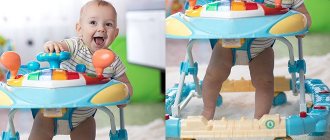Jumping jumper manufacturers advertise their product as a children's developmental simulator. Its affordable price and the natural desire of parents to accelerate the development of the child make the jumping device a very popular purchase. But are jumping bars really useful for the development of infants, and at what age can they be used?
The dangers of early planting
Until recently, the mother of a newborn girl was told horrors about the bending of the uterus from sitting down; the mother of a boy was frightened by the infertility that disposable diapers would definitely bring. These stories and myths are a thing of the past. For example, today it has been established that the harm from sitting down is the same for everyone. It consists of this:
- A sitting position, when the muscles of the back and abdomen are still weak, is a real blow to the spine. This can lead to disturbances in its development.
- Some parents place pillows and bolsters under the backs of their babies, hoping to reduce the load. This is also incorrect - the child’s pose is far from natural, therefore it is no less harmful than the first one.
A child seated in pillows - this should not be done
It is necessary to take into account the fact that the vertebrae are still weak and pliable. Most of all, when a baby is placed in a chair, the thoracic spine suffers, which in the future can lead to problems with the lungs and breathing.
How to help a child learn to walk?
Encourage your child to crawl and stand. Children begin to walk only after they learn to stand. But before that they learn to crawl. Crawling is a baby's first independent movement and lays the foundation for standing and walking.
Encourage crawling as it strengthens your baby's muscles. You can play games that exercise the muscles in your lower back and legs.
- lift the child to his feet. Once your baby is six months old, spend a few minutes every day holding your baby on his feet. This will help your baby get used to standing. He will learn to support his body weight on both soles. Body weight transferred to the knees strengthens the joints and stimulates the growth of leg muscles;
- arrange objects that help you stand. There are several support toys that are specifically designed to support your baby's body weight while he or she is standing. Buy one like this for your baby and place the toy nearby while he or she plays. The baby will grab onto it to help himself rise from a standing position;
- make walking easier at the beginning. When your child begins to walk but is not yet confident in his abilities, place support objects around him to help him hold on. Follow your baby as he travels, but let him move on his own.
Let the baby walk without assistance. When a child begins to walk without support, do not worry and do not rush to catch him. Instead, place your hands close, like a defender, while he slowly moves his feet. The child must learn to support his body weight on his legs. The work involves not only the muscles, but also the work of the brain and inner ear, which help maintain balance.
Does a child need jumpers: opinions for and against
Today, doctors are more loyal to jumpers, but still urge parents to exercise some caution. Jumpers, like any other device intended for use by young children, have a number of positive and negative characteristics. Jumpers, like any other device intended for use by young children, have a number of positive and negative characteristics
Jumpers, like any other device intended for use by young children, have a number of positive and negative characteristics.
| Negative properties |
| Causes a lot of positive emotions in the child, promotes the development of cognitive interest; 2. Allows the development of the vestibular apparatus; 3. Has a positive effect on the child’s intellectual development; 4. Helps to diversify motor activity, because the baby can now determine the position of his body and regulate the speed of movements; 5. Helps strengthen muscle tissue and the framework of the musculoskeletal system; 6. The child is busy with independent activities, which gives parents the opportunity to go about their business; 7. The space available to the child is limited, which means he will not be able to get close to potentially dangerous objects; 8. Jumpers are a good exercise machine for children who have any physical disabilities. | 1. The natural sequence of child development laid down by nature is disrupted. Initially, the baby gets to know the world around him and his body while in a horizontal position. The sharp “verticalization” of his body disrupts the natural course of events, which undoubtedly is a certain stress for the child; 2. Correct muscle tone is disrupted; if a child spends an unlimited amount of time in jumping jacks, the load on his legs, which are not yet ready for such overloads, increases significantly; 3. Compression of the perineal area occurs, which negatively affects the development of the genital organs (especially in boys); 4. With prolonged use of jumpers, the process of proper formation of the foot is disrupted, as a result of which the sense of balance is disrupted; 5. When jumping, the child relies on both feet at once, which in the future is fraught with problems with learning to walk: 6. Incorrectly secured jumpers create the risk of injury. |
Contraindications
- Irritation, inflammation of the skin;
- Allergic reactions that appear on the skin in places where the skin comes into contact with the seat of the jumpers;
- The child’s inability to hold his head confidently;
- Too early age (up to 3-4 months);
- Presence of orthopedic and neurological abnormalities.
Komarovsky is against it!
In one of his programs, the famous doctor speaks quite categorically about jumpers and other “verticalizing” devices. Komarovsky is confident that for normal physical development and a healthy spine, a child needs to remain in a horizontal position for as long as possible.
Crawling – sitting – walking is the only correct scenario for the development of motor skills in the first year. Skipping and skipping these stages is fraught with serious health problems in the future, the doctor warns.
And Komarovsky is sure that walkers are not needed by the child, but by his mother, who is tired of entertaining her child in her arms.
How to securely fasten
Before purchasing, check how the jumpers are attached so that it doesn’t come as a surprise at home.
Jumpers are attached to a hook Jumpers are secured using clips
- If you have chosen jumpers that are attached to nails, then you need to make sure that the wall is strong enough to support the baby’s weight: the wall should not be plasterboard or fragile. Jumpers can be hung on a dowel or driven into the wall with a hook.
- The hook can also be used to attach jumpers to the ceiling, which allows you to hang the structure anywhere in the room, not just in the doorway.
- Jumpers secured with clamps are suitable only for doorways, but they allow you to do without driving nails and hooks into the walls. The clamp comes with the jumpers and is a bracket with adjustment for different wall thicknesses for a strong fixation.
- After installing the entire structure, conduct a strength test with a weight exceeding the weight of the child. Press down with your hands using your weight.
Recommendations for use
- Choose a model that suits your baby. You decide for yourself at what month to put your baby in the jumper. But when purchasing, you should rely not on the manufacturer’s recommendations, but on the specific abilities of your baby.
- Do not leave your child unattended. Although jumpers are designed to free up parents for a while, they need to be placed so that the baby can be seen at all times.
- Before using for the first time, adjust the height of the jumpers: your foot should rest completely on the floor.
- The baby's feet should be shod, or you can place a massage rubber mat on the floor under the jumpers.
- You can use jumpers for no more than 20 minutes a day, starting from 5 minutes, gradually increasing the time you spend in the simulator.
- Do not place him in jumpers immediately after eating.
Contraindications
- Age less than 3 months, when the child is not yet holding his head.
- Congenital and acquired neurological diseases.
- Orthopedic disorders.
- Inflammatory diseases on the skin in the area of contact with the jumper's seat.
By weighing all the pros and cons, choosing the appropriate model and following the recommendations for use, you will bring your baby not only pleasure, but also benefit!
In the future, hanging jumpers can be used as a swing.
Continue reading All about walkers.
Very often disputes arise on the topic: “Jumpers for and against.” Evgeniy Olegovich Komarovsky (a famous pediatrician) speaks out unequivocally on this matter. Unlike many mothers and generous relatives, among whom there is an opinion that jumpers are the most successful gift for the birth of a baby, he has no doubts.
Design Features
Jumpers consist of a seat, fastenings and springs. The structure is installed in the doorway, mounted on a bar or on endoscopes. You can buy a similar simulator at any children's goods store. When choosing the appropriate option, pay attention to how the children's jumpers are attached.
Fastening
Based on the mounting method, models are distinguished:
- on hooks, screws and nails. The cheapest option, the disadvantage of which is the low reliability of the fastenings and the need to drive fastenings wherever you plan to use the simulator;
- on clamps (endoscopes). More expensive models. They are easy to move from one opening to another without hammering nails;
- on a stand. Mobile children's jumpers for indoors and outdoors. Disadvantage - a stable model can occupy an area of up to 4 m2.
Spring element
Jumpers use several types of spring elements. It helps your child to push off and jump easily:
- rubber. An inexpensive and short-lived design option, which, alas, cannot be passed on by inheritance. The rubber quickly wears out and breaks, causing the simulator to become unusable. An elastic band that breaks at the wrong moment can cause injury;
- spring. Sturdy, durable models with a spring can be used by several generations of kids. For safety reasons, the spring must be “dressed” in a cover.
seat
Based on the type of seat design, you can choose a model:
- with panty seat. The most affordable and easiest option. Can be made in the form of a soft toy or a favorite cartoon character. The downside is the lack of clamps. There is a risk of injury;
- with table top. A more bulky design, equipped with a circular bumper that protects against falls, a high soft seat, and fixing straps. On the tabletop there are multi-colored light bulbs, musical buttons and other educational elements. The disadvantage of the model is its bulkiness and rather high cost;
- in the form of a toy. A swing simulator made in the form of a car, airplane, rocket, etc. Develops the baby's thinking and imagination.
Sitting down on your own - how to react?
If a child is not six months old, but he knows how to hold his body with support, the desire to sit down will grow every day. After all, playing while sitting is much more interesting than just lying down. It is not worth laying and planting by force. The baby will again and again strive for a vertical position. In addition, persistent suppression of attempts to sit down can discourage the development of a skill and slow down natural development.
What should parents do?
- It is necessary to protect the baby as much as possible in case it falls and falls on its side.
- Distract and offer interesting activities while lying down.
A baby who has not yet sat down may be capricious when put to bed. To distract the child, parents take him in their arms. Doing it incorrectly can harm your posture. Do not allow a hanging position or sit on your arm or thigh.
What if a girl wants to sit up at four months of age? There is no point in encouraging early sitting down! Distract her, place her away from objects that she wants to grab onto and stand up.
Advantages and disadvantages
So, you need to use walkers with caution, observing all the rules and restrictions. In addition to the disadvantages of walkers, there are also undoubted advantages and disadvantages:
- Self-mobility training
in order to understand the world around us - this is an absolute benefit for the development of the baby.
- Active pastime
, allowing the child to get tired, and then eat well and sleep soundly.
- Child development with bright toys
and accessories that the product is usually equipped with.
Another advantage is the free time that mom and dad free up when the baby is busy with the walker - this is a definite plus for parents.
Modern walkers are not just devices for training the baby’s muscles, but also real multimedia entertainment stations that will not let the child get bored
When making a purchase decision, you need to clearly understand the harm from their use. The most significant negative consequences of use are:
Walkers usually begin to be used at 6-8 months. Nature provides that a child should crawl until he is 12, as this strengthens his muscles and forms his skeleton. Active upright walking in children should begin when they reach the age of 1 year. The consequence of early upright walking and the associated premature load on the back can be various curvatures of the spine.
Difficulties in learning to walk.
There is an opinion that with the help of a walker, on the contrary, a child will quickly learn to move independently - this is not entirely true. They do not teach the child how to maintain balance, because the position in which the child is in a walker does not teach him to walk. Pediatricians confirm that it is more difficult to put a baby using a walker on his feet and teach him to walk.
Walkers are a source of additional danger for a child.
In order to avoid the threat of various injuries, damage, bruises and abrasions, the child is not left alone in the walker. Independent chaotic movement around the apartment can become a source of health hazard.
If you use a walker wisely and in a timely manner, your baby can learn a lot with its help, and his development will accelerate. On the other hand, for a fragile musculoskeletal system, heavy loads are dangerous - the common sense of parents and their awareness come to the fore.
Jumper Danger
Of course, jumpers can give a child a few minutes of happiness and develop his or her horizons, but if used carelessly, they become dangerous to the life and health of the baby. Firstly, if they are not fastened well enough, they can break off, then the little explorer will receive a strong blow to the floor; at best, he will land on his butt, but it is possible that the child will also hit his head.
In addition, children's fragile bones should not be subjected to the same load as in jumping jacks. This is fraught with deformation of the legs, which may even prevent you from walking. Loading the perineum will also not be beneficial for the baby.
Not all parents know at what age a child can be placed in a jumper. Using this device for a child who is not physically ready for this type of stress can result not only in injuries, but also in improper formation of the skeleton.
Jumpers for children - video
From this short video you will learn how important it is to start using jumpers when your baby learns not only to stand, but also to walk on his own. This will prevent improper development of the back muscles, calf muscles, and tension of the entire spine
The safety of using jumpers lies in the baby’s consistent development: first, the baby learns to sit and crawl, and only then to walk and jump. It is advisable to entertain your baby in jumping jacks in doses, for a short time, starting from a few minutes. It is mandatory to secure the baby's foot in shoes; when jumping, the support should be on the entire foot.
As people say: “everything is good in moderation.” If you have jumpers, make sure your baby is safe and don't let him spend more than 20 minutes a day in them. The better your baby can walk on his own, the less harmful the effects of jumping jacks. You can buy a walker for your child, but make sure that the child does not fall and get a concussion.
How long can you jump?
Exercise on the simulator is a game. And the baby plays games depending on his mood. If the child does not show interest or is capricious, it is better to postpone introduction to the simulator.
Jumpers for children are a kind of exercise machine. Any workout is useful if it is dosed.
- The duration of stay in the jumpers should not exceed half an hour.
- Three minutes is enough for the first time. Then the time is gradually increased.
- The average duration of use of jumpers is 15-30 minutes.
- You can put your baby in the exercise machine up to three times a day.
Comfortable walkers for children: at what age can you use them?
Contrary to our aspirations and hopes, it is impossible to obtain detailed information about what time a child can be put into a walker, and professional experienced pediatricians refrain from giving specific instructions. It is impossible to establish exact dates, because absolutely all children do not develop equally, but individually. Therefore, in each specific case, you will have to decide at what time you can put your child in a walker in such a way as to comply with the combination of a number of factors.
- The first thing to consider is the age of the child. The baby, regardless of gender or weight, must first be at least six months old before you are going to buy him such a convenient device as a walker.
- The optimal age at which movement in a walker is indicated is considered to be about seven to eight months, just when the baby actively begins to strive to get up and learn to walk. This is due to physiological factors, and not superstition, as many people think. It is at this age that those muscles and muscles that are responsible for maintaining the body in an upright position develop.
- Finding out when that very moment has come and whether it is already possible to put the child in a walker is quite simple. He must learn to stand up, holding onto a support or the hands of his parents, but completely independently.
- Also make sure that your offspring sits confidently, without falling to one side, and can reach far away objects and toys, simply trying to reach them and not fall.
- The baby must learn to crawl on his own, after which he will want to get up. However, you need to understand that some children completely skip the crawling stage, learn to sit, and then immediately get up and walk, therefore this point can be called absolutely individual.
It is worth taking into account the child’s psycho-emotional readiness for this kind of “adventure”, such as moving around an apartment or house in a walker. And the walker itself should please him, captivate him, interest him, because if he stubbornly does not want to “climb” or sit in it, then it is better not to force the baby, it will do harm instead of good.
Girls
Parents of young representatives of the fair sex are interested in when it is possible to put them in walkers, believing that this may harm proper development. The thing is that doctors believe that girls are more susceptible to hip dysplasia, which can further affect genitourinary and reproductive functions, and generally lead to unpleasant consequences.
Every little girl, when she grows up, will definitely want to become a mother and give life to another little person.
Therefore, her health should be approached with special attention, and if a disease of this type has been diagnosed, then a walker will only aggravate the situation. Before putting your baby in a walker, check with a pediatrician, have her examined by an orthopedist, start doing special exercises to significantly improve her physical fitness, only then can you buy and use this convenient device
Boys
Due to the physiological characteristics of boys, many overly caring parents fear that being in a walker may harm the proper development of the genitourinary system of the future man. After all, the baby will rub and press his crotch against the seat of the walker, squeezing the genitals, which, in their opinion, will negatively affect his entire future life, but this is pure delusion.
Professional, experienced orthopedists and pediatricians confidently reject these misconceptions and believe that walkers for boys can be used based on the general recommendations that we gave above. The only thing worth considering is the time the baby spends in the walker. It should not exceed three to forty minutes at the initial stage (you can teach it for about two weeks, gradually increasing the sitting time), as well as one and a half hours a day until the baby learns to walk independently.
What attracts you about jumpers?
The so-called simulator is a structure with a seat that allows the baby to swing from side to side and bounce, pushing off the floor.
It’s hard to imagine how delighted babies are with this entertainment. Without even learning to sit, they are given the opportunity to view their surroundings in an upright position and independently control their body in the air.
Moms are happy too. Finally, your hands are free and you can do household chores. And the sight of a laughing child gives even more confidence that the exercise machine is really needed in the house.
Jumpers are also a good buy. They are relatively inexpensive. And after several months of use, the product retains a sufficiently presentable appearance to resell it or give it to friends.
Featured articles:
- Mattress for a newborn - which one is better to choose?
- How to choose a fitball for babies
- How to sterilize baby bottles
Possible consequences
Jumpers have a much greater negative impact on a small organism than a positive one. If parents use this simulator for a long time, they can provide their baby with:
- overload of the back muscles;
- scoliosis;
- as a consequence - incorrect position of internal organs, leading to digestive disorders;
- poor posture.
But this is just the tip of the iceberg. “Underwater” has no less sad consequences. So, in jumping shoes, the child’s perineal area is compressed. This is harmful for both boys and girls, as it leads to disruption of the urinary system and can also cause deformation of the hip bones.
The possibility of movement is limited, in particular crawling, which helps to form a strong and healthy spine with the help of strong muscles and healthy ligaments. This can lead, in addition to scoliosis, to pinched nerve endings, radiculitis, and intervertebral hernias.
When a child jumps, only the lower part of the body is actively involved. Accordingly, the load he receives is less than when crawling, and besides, it is uneven. Overloading fragile leg bones can cause them to deform.
The child gets used to leaning only on his toes. This forms improper tone of the foot muscles, inhibits the development of balance (and does not accelerate, as the manufacturers claim!).
With prolonged use of jumpers, the baby gets used to leaning on both feet at the same time, which inhibits the formation of correct coordination, in particular when mastering the skill of walking. It will be difficult to teach a child to step with his legs one at a time (besides, without springing, as in jumping shoes). So he may go later, not earlier. There is another reason for this: when jumping, the baby’s leg muscles develop incorrectly – only the calf muscles are used during jumping. And the quadriceps, necessary for walking, receive virtually no load. Accordingly, they develop much more slowly.
Limiting crawling makes the baby's arms underdeveloped, and this can affect his mental development, because the parts of our brain are interconnected.
By the way, about the brain. It is not adapted to assimilate external information during springy movements, so it receives a huge, but completely unnecessary load: in the future, the child will not move by jumping, so there is no need to load the brain with useless work.
Few people think about the emotional sphere, believing that the child experiences only wild delight. Yes, but there may be another danger behind it: young children very quickly get used to the constant release of adrenaline into the blood. In the future, parents will have to constantly look for new ways to get such pleasure for the growing extreme sports enthusiast. This is why there are so many opponents to the so-called dynamic gymnastics (we talked about it in detail here).
Well, to top it all off, it can be noted that jumpers are not nearly as safe as marketers claim. The child may hit door frames or supports (if the device is floor-mounted), become frightened and injured.
How to choose jumpers
When choosing this simulator, pay attention to all the accompanying certificates of quality and compliance. Jumpers must be made of safe and non-toxic materials.
Children's jumpers can be of several types:
- With plastic bumper. Thanks to the presence of a plastic table on which buttons and a music panel with toys are located, the child will not hit the door frame. But there is also a minus in this model: the baby does not see his legs, which means that his leg movements are not fully conscious.
- With panty seat. This option is quite cheap, but that’s where its advantages end. If the model is not equipped with special fixing straps and bolsters to support the child under the arms, then the entire load in such jumpers will fall on the perineum, and this is strictly prohibited.
- There is another, best (and most expensive) option - floor-supported jumpers. This is a rather heavy and bulky structure that will require a lot of free space (about 4 m2). But this model is the safest for a child.
Popular manufacturers
Every parent who has used a walker can confidently name the world's most famous manufacturers. However, there are also products from little-known companies on sale. What to prefer?
Walking structures are traditionally divided into 2 main groups:
- walkers from popular brands from Italy and China: Italian Peg-Perego, Chicco, Brevi and Chinese Barty. The products of these companies are expensive, but are distinguished by high quality and workmanship;
- walkers from China, Poland and Russia: Selby, Baby Care, Happy Baby, Capella, “Firefly”. Such products are cheap, but are still high quality and safe.
Do you need to pay extra for a well-known brand? It's up to the parents to decide. Of course, you want to buy the best product for your kids, but walkers will only last a few months, and then they will be put aside because they are no longer needed.
You should abandon “nameless” products and goods from little-known companies. Such walkers will either break quickly or even harm the child.
When should I stop using jumpers?
The baby himself will determine this. Usually, the older he is, the more interest he shows in other activities, and he no longer needs jumping jacks, because he can move around on his own!
When your baby learns to crawl (around 6 months), you should limit the use of jumpers and prefer crawling! Since it develops the child’s muscular system much better.
At this age, jumping games turn from educational to entertaining. They simply help you keep your child occupied while you do household chores.
These days, the children's goods market is overflowing with various devices and innovations designed to organize the leisure time of a young explorer. Jumpers, and centers, swings - if the financial capabilities of the parents allow, then any child can choose an activity to their liking. In particular, from the age of 3-4 months, caring mothers and fathers rush to include baby jumpers or the so-called developmental simulator in the list of mandatory purchases. What are the advantages of this device and how safe it is for a small, fragile organism, let’s try to figure it out. And most importantly, let’s find out at how many months you can put your baby in a jumper.
Miracle jumpers through the eyes of pediatricians
According to the manufacturer, the developmental simulator is an unusually useful thing that will give the mother minutes of precious rest and the baby a lot of positive emotions. In addition, jumping exercises strengthen the vestibular apparatus, help master upright walking skills, improve coordination and strengthen muscles, and promote mental development. Of course, if you believe everything that has been said, then it’s scary to even imagine how children used to grow up without this wonderful invention. Leading specialists in the field of pediatrics are also very skeptical about jumpers. According to them, the device can have an extremely negative impact on the development of the lower extremities and spine, the appearance of “jumping” dependence and improper formation of walking skills.
However, despite conflicting reviews, many parents still decide to experiment, and then the question of at what age a child can be put into jumping shoes is put on the agenda.
From what month can a small child be placed in a jumper?
Models of exercise machines with a special device for supporting the back are recommended for use from 3-4 months. But if you ask the question, what time can you put boys and girls in such jumping jacks to a pediatrician, the answer will be somewhat different.
After six months, or even later, you can leave a small child in the simulator for a short time. Because before this age, the baby’s spine is still too weak and not designed for such loads. Doctors agreed that it is possible to put both boys and girls in jumping jacks when the child confidently holds his head, sits and can make pushing movements with his leg. Little girls especially should not rush and get carried away with such activities; this is due to the physiological characteristics of the development of not only the musculoskeletal system, but also the reproductive system.
At what time can boys and girls be put into jumping rinks is not a relevant question for children with neurological and orthopedic disabilities.
Modern manufacturers offer a huge selection of exercise equipment for the little ones. For example, pushing off the floor with your feet and jumping lightly are very popular.
This kind of entertainment delights many babies. However, it should be remembered that it is not suitable for all children.
Today we will tell you at what age you should use jumpers and how to choose them correctly.
The proper development and good health of a child largely depend on regular physical exercise and positive emotions. These two conditions are combined by jumpers. They help the baby actively explore the world around him, and help mommy carve out a little free time for household chores.
Negative influence of jumpers
Despite their great popularity, jumpers cause a lot of controversy about their benefits or harm. The first question parents are interested in is: “At what month can you start using jumpers?” On the packaging of this device, as a rule, the age is indicated - from 3 months to 3 years. What can jumping jeopardize a three-month-old baby? Further problems with the back and the entire musculoskeletal system in general. At such an early age, the back muscles are so weak that the entertainment of jumping jacks will be a real challenge. This type of entertainment for children cannot fully provide back support, and all the support will be on the perineum area (which will also not be beneficial) and the fragile bones of the spine. Thus, wanting to get a few minutes of rest or the opportunity to go about their business, parents expose their baby to great danger, because disorders of the musculoskeletal system will affect the functioning of the entire body, causing disturbances in almost many organs.
So, to the question “At what months can you start using jumpers?” Doctors give a clear answer. This will not harm the child only if the back muscles have become a little stronger and the baby can sit independently, which means not earlier than 6-7 months.
Another negative point: children's jumping jacks contribute to incorrect foot placement. In this device, the child pushes off with both legs, remembering this sensation, and learning to walk, he will try to push off as well, which means he will constantly fall. For this reason, children who were often in jumping stations begin to walk later than their peers.
Contraindications for use
Before purchasing a developmental simulator, be sure to visit a pediatrician, orthopedist, or pediatric neurologist. Check with specialists to see if your baby can be in the jumpers. Doctors often dissuade the idea of early jumping, especially if the child is weak, was born prematurely, or there are suspicions of rickets or diseases of the musculoskeletal system.
There are other restrictions:
- skin diseases;
- diaper rash, dermatitis localized in the area of the legs, buttocks, groin;
- the child still does not hold his head well, the muscle corset is weak, after being placed in the pants-seat, the baby “falls over” to the side or forward/backward;
- orthopedic, neurological diseases.
Important! Violation of prohibitions negatively affects the condition of the muscles, bone frame, and the formation of the foot. Consider this point if you are wondering who to listen to: an experienced pediatrician or an all-knowing neighbor (“And mine has been in jumpers since three months, nothing, everything is fine”). Some problems from early placement of a child in a position that is unnatural for his age do not arise immediately, but after 2–3 months or six months
Some problems from early placement of a child in a position that is unnatural for his age do not arise immediately, but after 2-3 months or six months.
How is the skill of sitting down developed?
Sitting is a skill. Moreover, one of the most difficult, mastered by children by the age of one year. It consists of:
Desires. If a child wants to see something more than can be seen lying down, for example, from a stroller on a walk, he will try to do everything to change the position of his body. Physical skills. This sums up the activities of parents and children (massages performed by the mother, professional massage and swimming in the pool are especially useful), and the freedom of movement of the latter. This includes weight, since it directly affects physical development, but is not related to health. Baby's well-being
It is important not to miss routine examinations by a pediatrician, surgeon, or orthopedist. If your baby has a disease that may interfere with development, it needs to be treated.
This formula does not include forced sitting on the butt.
Important! Some mothers believe that if they don’t show how to sit, the baby won’t understand it on his own for a long time. You can “introduce” your baby to the sitting position using a special exercise that will not cause harm, unlike sitting down ahead of time
The mother gives her thumbs to the child lying on his back. The baby should try to pull himself up and sit down. The parent should not drag him upstairs.
Squatting exercise
At what age do parents think about purchasing jumpers?
The average age at which adults place a baby in a jumper is 3-4 months.
If a child is holding his head confidently by the age of 2 months, then you can try putting him in a jumper, but only after consulting with a pediatrician, orthopedist and neurologist.
If you listen to the advice of a famous pediatrician, then in his video where he discusses the topic “Jumping walkers: pros and cons,” Komarovsky does not give a clear answer at what age you can use these devices. At the same time, he clearly articulates the idea that the time the child will spend in them should be minimal.
But most often this developmental simulator is recommended for children after 4 months. For this age, models are selected that have devices for support in the armpit area.
If the child is more than 6 months old, you can already buy other jumpers for him; the age is just such that a model without support is suitable.
Experts who are in favor of jumpers recommend starting to use them when the baby already knows how to hold toys in his hands, tries to manipulate them and tries to actively explore the surrounding reality.
Follow safety precautions
If the choice has been made and you want to buy jumpers for your child, photos of happy children in this device haunt you, and you want to please your little one, then you need to follow a number of safety measures. This will reduce all risks to a minimum.
- Limit the time your child spends in the bouncers. It should be no more than 15 minutes at a time. You can “jump” several times a day.
- When the child has not yet learned to sit, to reduce the load on the spine, the baby’s posture is fixed with special straps that are pulled under the armpits. When the spine gets stronger, these straps can be removed.
- Before letting your child “jump freely”, it is worth checking the accessibility of the edges of the furniture, which the child may be injured by when accidentally colliding with them.
It is clear that opinions about the dangers and benefits of jumping jacks differ, but you should approach everything by listening to common sense. After all, a child can grow up healthy and strong in jumpers, but he can have a bunch of health problems if he has never been put in either a jumper or a walker. Everything is very individual, and you should focus only on your baby and the state of his health today.
More and more children's exercise equipment is becoming available to parents. Many people have questions: “Are baby jumpers necessary for my baby?”, “Will using them help strengthen the leg muscles?” and “When can I put my child in jumping chairs?”
Jumpers are a simulator consisting of a seat secured with springs or elastic bands to different types of structures. While in them, the child touches the floor with his feet and begins to actively jump, obeying the innate support reflexes.
It is recommended to place a child in a jumper no earlier than 6 months for 7-10 minutes
Types of jumpers (photos clickable)
Principle of operation










